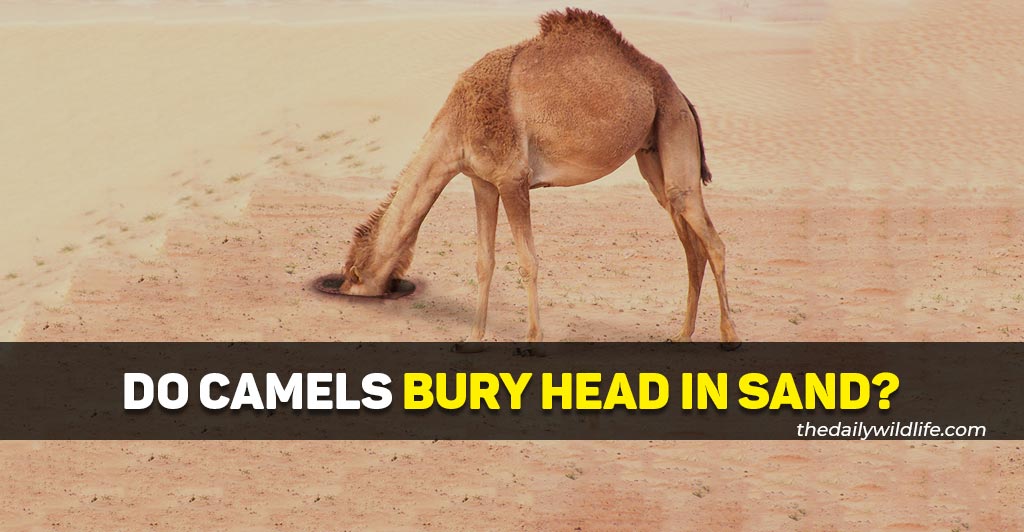Contrary to popular belief, camels do not bury their head in sand. Having their heads stuck in the sand would be detrimental to camels.
Unlike camels, some animals do put their head in the sand.
Some do it to hide from predators, others to ambush their prey, and some to cool down and survive the scorching desert sun.
Camels are not one of those animals.
Here are 2 main reasons for that.

2 Reasons Why Camels Don’t Bury Their Heads In Sand
Camels don’t bury their head in sand because they wouldn’t be able to breathe properly and because it would make them more vulnerable to predators.
1. Head In Sand Prevents Proper Breathing
Like mammals, camels need oxygen to function properly. Burying heads in the sand would stop them from breathing.
Despite having flexible nostrils that can close at will, camels still need to breathe.
When nostrils are closed, they breathe through their split lips.
With their head in the sand, larger particles would get into their throat, but these could be expelled by coughing.
The issue is those very small, fine particles (particulates).
They could cause serious health issues to the animal, even death, if these reached deep into the lungs.[1]
2. Head In Sand Increases Risk Of Predator Attack
If camels put their heads in the sand, they would not be able to see an approaching predator and try to flee.
In recent decades, the number of natural camel predators has decreased.
The cases of lions, tigers, and somewhat leopards attacking camels have been lower and lower.
Their numbers (of wild cats) have been decreasing, the territory they cover as well, so today they almost do not get in contact with camels.
Despite that, one predator still poses a threat to camels – wolves.
Wolves have excellent eyesight; they can see up to 75 feet away, and their sensitive noses allow them to smell prey 1.5 miles away.
Even if camels put their head in the sand, and for some reason, a wolf would not be able to see these over-7-feet-tall animals, camels still emit a strong odor that wolves would easily pick up and locate the defenseless animal.
And with their heads stuck in the sand, camels wouldn’t be able to try to run away from danger.
Do Camels Bury Their Head In The Sand To Counter The Wind In The Desert?
Camels do not bury their head during a sandstorm because they wouldn’t be able to breathe and because their third eyelid prevents desert sand from hurting their eyes.
This would seem like quite a logical move, no?
During a sandstorm, the wind blows huge amounts of sand that can get inside the animal.
Too much sand in the lungs, eyes, ears, or intestines can lead to serious health problems, including death.
So burying their head in the sand and waiting for the wind to pass seems like a smart move.
Except camels are already well-equipped for those situations.
They developed small and hairy ears to stop sand from getting inside, they can close their nostrils to stop it from getting inside their lungs, and they developed a translucent eyelid that stops dust particles from scratching their eyes and even enables them to see during a sandstorm.
There’s no reason for them to keep their heads in the sand, not even during sandstorms.
Final Thoughts
Camels have adapted to almost anything nature throws at them.
Extreme temperatures? – Thick fur to prevent sweating and water loss.
Sandstorms? – Hair in ears, long lashes, and ability to close nostrils.
Predators? – Long legs to try to spot and run away from them.
Because of these adaptations, they do not need to hide in the sand.
Camels do not bury their head in sand as it would make them more susceptible to predator attacks and prevent them from breathing properly. Even during a sandstorm, they can use a third eyelid that stops dust particles from injuring their eye.
This concludes our article on the question of “do camels bury their head in sand”.
We hope you found it informative and interesting.
P.S. There is a popular myth that some animals like ostriches put their head in the sand when they get frightened.
This couldn’t be further from the truth.
They do that to rotate their eggs that are in their nest deep in the ground so they are all warmed up evenly.
References[1] Sand, Dust, and Particulates, U.S. Department of Veterans Affairs